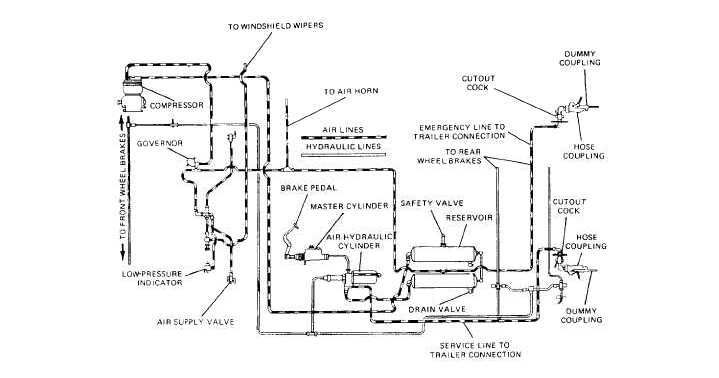AIR-OVER-HYDRAULIC
On vehicles equipped with air-over-hydraulic brakes (fig. 6-12), do a good visual inspection of the air compressor, the air reservoir, the air lines, the brake pedal and linkage, the wheel brakes, the master cylinder, and the hydraulic line from the master cylinder to the air-hydraulic-power cylinder and from the air-hydraulic power cylinder to the wheel brakes.
Operating troubles resulting from malfunction of the air-over-hydraulic power cylinder are hard pedal (excessive pedal pressure required to apply the brakes) and dragging brakes (power cylinder fails to return to released position when the brake pedal is released).
To test a sluggish or inoperative power cylinder, first install an air pressure gauge in the control valve housing and a hydraulic gauge at both the hydraulic fluid inlet line and the hydraulic brake line output port. Then slowly depress the brake pedal and observe the gauges. When the air control pressure gauge shows between 1 and 5 psi, the hydraulic pressure at the hydraulic inlet should not exceed 40 psi. Excessive hydraulic pressure indicates a sticking relay piston (caused by swollen or damaged piston scaling cups or a corroded or damaged relay piston sleeve) or sticking control valve poppets (caused by corrosion of the poppets, poppet seats, or damaged poppets).
With the brake pedal completely depressed in the fully applied position, the air control pressure gauge should show 90 psi and the hydraulic output pressure gauge should show full power (runout) pressure of 1,400 to 1,600 psi. Low pressure or no pressure on the air pressure gauge indicates air leakage or an inoperative control valve. Low hydraulic output pressure indicates hydraulic fluid leakage, a sticking hydraulic piston, or an inoperative check valve (in the hydraulic piston), or a residual line check valve.
To test for internal and external air leakage or hydraulic leakage, fast depress the brake pedal and apply soapsuds at the air control line and its connections, the double check valve (if so equipped), and the cylinder body and end plate. Bubbles appearing at any of these points indicate external air leaks. While the pedal is depressed, check for hydraulic fluid leakage at the outlet fitting cap and around the jam nut on the slave cylinder housing. Internal air leakage is indicated by a pressure drop in excess of 2 psi in 15 seconds. The trouble is a worn or damaged piston packing, a scored cylinder body, or leakage at the poppets in the control valve. Internal hydraulic pressure leakage can also be indicated by hydraulic pressure drop at both hydraulic pressure gauges while the brake pedal is depressed.
Dragging brakes can be tested by releasing the brake pedal and observing the air pressure gauge and the two

Figure 6-12. - Air-over-hydraulic brake system.
Continue Reading